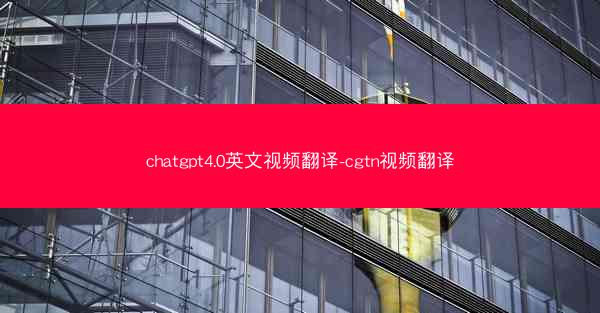chatgpt4.0英文视频翻译-cgtn视频翻译

Introduction to ChatGPT 4.0 and CGTN Video Translation
In the rapidly evolving field of artificial intelligence, the release of ChatGPT 4.0 has marked a significant milestone. This advanced language model, developed by OpenAI, has the capability to understand and generate human-like text, making it a powerful tool for various applications, including video translation. In this article, we will delve into the details of ChatGPT 4.0 and its application in translating CGTN videos.
Understanding ChatGPT 4.0
ChatGPT 4.0 is the latest iteration of the GPT (Generative Pre-trained Transformer) series, which has been widely recognized for its ability to produce coherent and contextually relevant text. Here are some key aspects of ChatGPT 4.0:
1. Language Understanding: ChatGPT 4.0 has been trained on a vast amount of text data, enabling it to understand the nuances of human language, including idioms, slang, and cultural references.
2. Contextual Generation: The model can generate text that is contextually appropriate, ensuring that the translated content is not only accurate but also flows naturally.
3. Adaptability: ChatGPT 4.0 can adapt to different styles of writing, whether it's formal, casual, or technical, making it versatile for various translation needs.
4. Efficiency: The model operates at a high speed, translating videos in real-time or near-real-time, which is crucial for live broadcasts or time-sensitive content.
Application in CGTN Video Translation
China Global Television Network (CGTN) is a leading international news organization, providing news coverage in multiple languages. The application of ChatGPT 4.0 in translating CGTN videos offers several advantages:
1. Accuracy: The advanced language processing capabilities of ChatGPT 4.0 ensure that the translated content is accurate, reducing the risk of misunderstandings or misinterpretations.
2. Consistency: The model maintains consistency in translation, ensuring that the same terms or phrases are used consistently throughout the video.
3. Speed: With the ability to translate videos quickly, ChatGPT 4.0 can help CGTN meet the demands of a global audience that expects immediate access to news.
4. Accessibility: By providing translated content, CGTN can reach a wider audience, including those who are not fluent in the original language of the video.
Technical Aspects of Video Translation with ChatGPT 4.0
The process of translating videos using ChatGPT 4.0 involves several technical steps:
1. Audio Extraction: The first step is to extract the audio from the video, which is then processed by the language model to generate the translated text.
2. Text-to-Speech (TTS): Once the translated text is ready, it is converted into speech using TTS technology, ensuring that the translated content is presented in an audible format.
3. Synching: The audio generated by the TTS is then synchronized with the original video, ensuring that the translated content aligns with the visuals.
4. Quality Control: A final quality control step is essential to ensure that the translated video is of high quality and free from errors.
Challenges and Limitations
Despite its advanced capabilities, ChatGPT 4.0 faces certain challenges and limitations in video translation:
1. Complexity of Language: Some languages are inherently more complex than others, making it challenging for the model to produce accurate translations.
2. Cultural Nuances: Certain cultural references or idioms may not translate well, leading to potential misunderstandings.
3. Technical Limitations: The process of extracting audio and synchronizing it with video can be technically challenging and may not always result in perfect alignment.
4. Ethical Considerations: There is a concern about the potential misuse of AI in spreading misinformation or manipulating content.
Future Prospects
The integration of ChatGPT 4.0 in video translation marks the beginning of a new era in the field of language processing and AI-driven content creation. Here are some future prospects:
1. Continuous Improvement: With ongoing research and development, the accuracy and efficiency of AI-driven video translation are expected to improve significantly.
2. Broader Language Support: As the technology matures, it is likely that more languages will be supported, expanding the reach of content creators.
3. Enhanced User Experience: The integration of AI in video translation can lead to a more seamless and accessible user experience for viewers worldwide.
4. New Opportunities: The advent of AI-driven video translation opens up new opportunities for content creators and distributors to reach global audiences.
In conclusion, the application of ChatGPT 4.0 in translating CGTN videos represents a significant step forward in the field of AI and language processing. While challenges and limitations exist, the future holds promising possibilities for the continued advancement of this technology.
